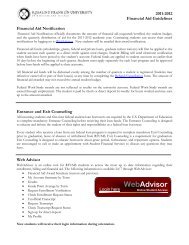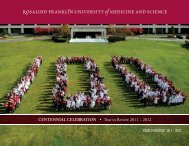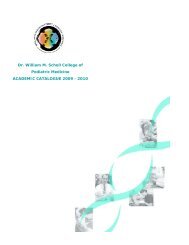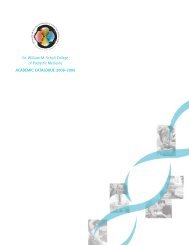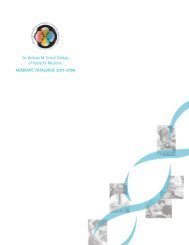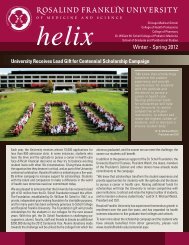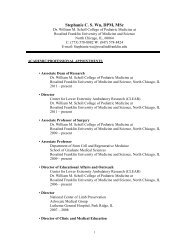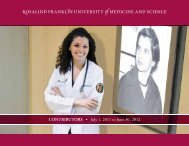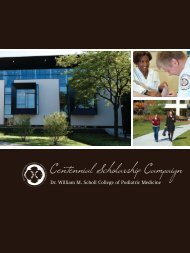H.M. BLIGH FACULTY - Rosalind Franklin University
H.M. BLIGH FACULTY - Rosalind Franklin University
H.M. BLIGH FACULTY - Rosalind Franklin University
Create successful ePaper yourself
Turn your PDF publications into a flip-book with our unique Google optimized e-Paper software.
Bala Chandran, M.S., Ph.D.<br />
Professor and Chair<br />
Room: 2.300<br />
Telephone: 847.578.8822<br />
E-mail: bala.chandran@rosalindfranklin.edu<br />
H.M. <strong>BLIGH</strong> <strong>FACULTY</strong><br />
Bala Chandran, M.S., Ph.D.<br />
Dr. Chandran received his M.S. from Jawaharlal Institute of Post-Graduate Medical Education and Research in<br />
Pondicherry, India in 1974, and his Ph.D. degree on vaccinia virus immunobiology from All-India Institute of<br />
Medical Sciences in New Delhi, India in 1979. Dr. Chandran’s postdoctoral experience includes positions at the<br />
Cancer Research Group at McMaster <strong>University</strong> in Hamilton and the Department of Comparative and Experimental<br />
Pathology at the <strong>University</strong> of Florida in Gainesville. An award-winning teacher, Dr. Chandran was appointed<br />
Assistant Professor in the Department of Microbiology, Molecular Genetics and Immunology at the <strong>University</strong> of<br />
Kansas Medical Center in 1986, and then Professor in 1996. Dr. Chandran joined the Department of Microbiology<br />
and Immunology at <strong>Rosalind</strong> <strong>Franklin</strong> <strong>University</strong> of Medicine and Science on July 1, 2005 as Professor and Chair.<br />
Research<br />
Molecular biology of the herpesviruses is under study to elucidate their mechanism of pathogenesis. Kaposi’s<br />
sarcoma associated human herpesvirus (KSHV) or HHV-8 is a new herpesvirus implicated in the etiology of AIDSrelated<br />
Kaposi’s sarcoma, primary effusion lymphoma and multicentric Castleman’s disease. KSHV produces<br />
several unique proteins that regulate cell cycle, signaling, angiogenesis and immune system. The molecular<br />
events in KSHV infection of target cells are under study to understand how KSHV manipulates the host cell for a<br />
successful infection. Studies in progress include: a) Defining the cell surface molecules recognized by KSHV and<br />
the role of viral envelope glycoproteins in the cell surface receptor interactions; B) Signaling pathways induced<br />
by KSHV during infection and their role in infection; C) Viral gene expression during infection; and D) Modulation<br />
of host cell genes by KSHV. These studies provide unique opportunity of utilizing cutting edge molecular and cell<br />
biological techniques to examine viral oncogenesis by integrating cell surface receptors, signaling molecules,<br />
cellular processes, cell cycle regulatory molecules, transcription factors, innate immune responses and angiogenic<br />
factors. A thorough understanding of KSHV pathogenesis from these studies will lead to novel methods to control<br />
KSHV infection. Dr. Chandran’s research has been continuously funded by NIH and NCI. He is a member of the<br />
Editorial boards of the Journal of Virology and Human Virology. He has served as a member in NIH, MRC (UK) ,<br />
ACS and other grant review panels.<br />
2005-2010 Report
H.M. <strong>BLIGH</strong> <strong>FACULTY</strong><br />
David N. Everly, Ph.D.<br />
Assistant Professor<br />
Room: 2.252<br />
Telephone: 847.578.8653<br />
E-mail: david.everly@rosalindfranklin.edu<br />
David N. Everly, Ph.D.<br />
Dr. Everly received his B.A. in Biology in 1991 from William Jewell College in Liberty, MO. He received his Ph.D. in<br />
Cell Biology and Biophysics, and Molecular Biology and Biochemistry from the <strong>University</strong> of Missouri-Kansas City<br />
in 1998 studying herpes simplex virus virion host shutoff. He continued his studies at UMKC from 1998-2001<br />
as a postdoctoral fellow. In 2001 he joined the laboratory of Nancy Raab-Traub in the Linberger Comprehensive<br />
Cancer Center at the <strong>University</strong> of North Carolina-Chapel Hill to study tumor virology and Epstein-Barr virus. He<br />
was appointed Research Assistant Professor in 2006 in the department of Microbiology and Immunology at UNC.<br />
Dr. Everly joined the Department of Microbiology and Immunology as an Assistant Professor at <strong>Rosalind</strong> <strong>Franklin</strong><br />
<strong>University</strong> of Medicine and Science in August of 2007.<br />
Research<br />
Epstein-Barr virus (EBV) is a ubiquitous infectious agent that infects greater than 90% of the world’s population<br />
and is the etiologic agent of infectious mononucleosis. EBV is also a DNA tumor virus that is associated with a<br />
number of human malignancies and efficiently transforms B-lymphocytes. Burkitt’s lymphoma and nasopharyngeal<br />
carcinoma are highly associated with EBV, while some types of Hodgkin disease and some gastric cancers<br />
contain EBV. EBV-infected B-cell lymphomas are a significant complication of immunosuppressed conditions,<br />
including post-transplant and AIDS-associated lymphomas. Our laboratory studies the cellular signaling pathways<br />
that are important for different aspects of EBV biology. First, in viral oncogenesis, we are interested in latent<br />
membrane protein 1 (LMP1) and its role in EBV-associated cancers. LMP1, termed the EBV oncogene, is expressed<br />
in most EBV-associated cancers, is essential for B-cell transformation, and is sufficient for rodent fibroblast<br />
transformation. Our studies using rodent fibroblast transformation have yielded new insights into the mechanisms<br />
of transformation by LMP1, including regulation of cell cycle proteins and definition of pathways required for<br />
transformation. A second interest in the lab concerns signaling cascades induced by EBV infection. Binding of<br />
viruses to their cellular receptors not only gives the virus a point of entry into the infected cell but also initiates<br />
signaling pathways important for the establishment of an environment favorable for viral infection and survival<br />
of the infected cell. Understanding signaling pathways and factors induced by EBV infection will define new areas<br />
of viral pathogenesis. Each newly defined mechanism will illuminate new potential points of intervention in viral<br />
infection and oncogenesis.<br />
2005-2010 Report
Patricio I. Meneses, Ph.D.<br />
Assistant Professor<br />
Room: 2.351<br />
Telephone: 847.578.8835<br />
E-mail: patricio.meneses@rosalindfranklin.edu<br />
H.M. <strong>BLIGH</strong> <strong>FACULTY</strong><br />
Patricio I. Meneses, Ph.D.<br />
Dr. Meneses received his B.S from the State <strong>University</strong> of New York at Stony Brook, Stony Brook, NY in 1990,<br />
and his Ph.D. Cornell <strong>University</strong> Medical College, New York, NY in 1999. He did his postdoctoral fellowship in the<br />
laboratory of Dr. Peter M. Howley in the Department of Pathology at Harvard Medical School. Dr. Meneses went on<br />
to the position of Senior Research Investigator at the <strong>University</strong> of Pennsylvania School of Medicine Department<br />
of Neurology, and Microbiology and Immunology. He joined the Department of Microbiology and Immunology at<br />
<strong>Rosalind</strong> <strong>Franklin</strong> <strong>University</strong> of Medicine and Science on January 1, 2006, as Assistant Professor.<br />
Research<br />
Cervical cancer is one of the leading causes of death in women worldwide. Papillomaviruses have been<br />
demonstrated to be the etiologic agent associated with over 99% of cervical cancers. Our interest lies in<br />
understanding the mechanism utilized by papillomavirus to establish a primary infection. The laboratory focuses<br />
on the role of the papillomaviruses minor capsid L2 during infection. This work has led to the discovery that<br />
BPV-1 and HPV16 traffic through a novel pathway that includes clathrin coated pits, caveolin-1 vesicles, and the<br />
endoplasmic reticulum (ER). This trafficking seems to be an L2 mediated event. In part, L2 mediates this event<br />
by its interaction with the ER cellular protein syntaxin 18 that is involved in vesicle trafficking into and out of<br />
the ER. Our work was the first description of PV trafficking through the ER, a property shared by its papovavirus<br />
family members SV40 and murine polyomavirus. In addition to the role of L2 in intracellular trafficking, we have<br />
identified several novel interactions of L2 that suggest its role in 1) cellular senescence, 2) cell cycle regulation,<br />
and 3) regulation of the innate immune response. These are potential novel properties for a capsid protein. We<br />
have also identified a region of L2 that is highly conserved in all PV genotypes, as well as in other envelope and<br />
nonenveloped proteins involved in viral entry, whose mutation prevents infection. This region is being explored as a<br />
potential anti-viral target. The studies of the entry and intracellular trafficking mechanism used by papillomavirus<br />
described by our group may be relevant to multiple non-enveloped and enveloped viruses. In addition, PVs can be<br />
a very useful tool that can lead to a better understanding of the dynamic mechanism of basic cellular endocytosis,<br />
intracellular trafficking, and sorting. Our laboratory has received funding from NIH/NCI, the American Cancer<br />
Society, and the H. M. Bligh Cancer Research Laboratories.<br />
2005-2010 Report
Neelam Sharma-Walia, Ph.D.<br />
Research Assistant Professor<br />
Room: 2.416,<br />
Telephone: 847.578.3000 x 7777<br />
E-mail: neelam.sharma-walia@rosalindfranklin.edu<br />
H.M. <strong>BLIGH</strong> <strong>FACULTY</strong><br />
Neelam Sharma-Walia, Ph.D.<br />
Dr. Sharma-Walia received her Ph.D. in Experimental Medicine and Biotechnology from the Postgraduate Institute<br />
of Medical Education and Research, Chandigarh, India in 1998. She was appointed as Senior Demonstrator in<br />
the Department of Experimental Medicine and Biotechnology, Postgraduate Institute of Medical Education and<br />
Research, Chandigarh, India from 1998-2000. She worked as postdoctoral fellow in the Northwestern <strong>University</strong><br />
Medical School, Chicago in 2001 and in the Department of Microbiology, Molecular Genetics and Immunology at<br />
<strong>University</strong> of Kansas Medical Center from 2002-2005. She joined the <strong>Rosalind</strong> <strong>Franklin</strong> <strong>University</strong> of Medicine and<br />
Science in July, 2005 as a Research Assistant Professor.<br />
Research<br />
Our initial studies have shown that Kaposi’s sarcoma associated herpesvirus (KSHV) envelope associated<br />
glycoproteins gB has the ability to induce the integrin-dependent pre-existing FAK-Src-PI-3K-Rho GTPase signal<br />
pathways in host cells, and glycoprotein gpK8.1A has the potential to induce a robust ERK1/2 response in human<br />
microvascular endothelial cells and in human foreskin fibroblast cells, which in turn may provide a very conducive<br />
environment for the successful infection of target cells.<br />
Our previous studies also show the upregulation of prostaglandin pathway’s major stress angiogenic protein COX-<br />
2 and its lipid metabolite PGE2 in the endothelial cells strictly displaying viral latency and Body-cavity B-cell<br />
lymphoma (BCBL) cells carrying multicopy viral genome. Our studies showed that KSHV induced COX-2/PGE2 play<br />
important role in KSHV pathogenesis related events like inflammation, invasion, angiogenesis and cell survival.<br />
Using a variety of cutting edge technologies, we are currently deciphering the role of prostaglandin pathway in<br />
KSHV episome maintenance, chromatin remodeling, PEL/endothelial interactions. Our research also focuses on the<br />
identification of the cellular and viral factors involved in the stability of COX-2 and continuous regulated secretion<br />
of PGE2 in KSHV positive lymphoma cells.<br />
2005-2010 Report
H.M. <strong>BLIGH</strong> <strong>FACULTY</strong><br />
Gulam Waris, Ph.D.<br />
Assistant Professor<br />
Room: 2.349,<br />
Telephone: 847.578.3000 x 7774<br />
E-mail: gulam.waris@rosalindfranklin.edu<br />
Gulam Waris, Ph.D.<br />
Dr. Waris received his Ph.D. degree in Biochemistry from Aligarh Muslim <strong>University</strong>, Aligarh, India in 1999. He<br />
completed his postdoctoral fellowship on viral hepatitis B and C in the laboratory of Dr. Aleem Siddiqui at the<br />
<strong>University</strong> of Colorado Health Sciences Center (UCHSC), Denver. Dr. Waris was appointed as an Instructor in the<br />
Department of Microbiology at UCHSC, and later moved to Division of Infectious Diseases, Department of Medicine<br />
at <strong>University</strong> of California, San Diego, in 2005, as Assistant Project Scientist. Dr. Waris joined the Department<br />
of Microbiology and Immunology at <strong>Rosalind</strong> <strong>Franklin</strong> <strong>University</strong> of Medicine and Science on March 1, 2007, as<br />
Assistant Professor.<br />
Research<br />
Chronic liver disease due to infection with hepatitis C virus (HCV) is a major global health problem that currently<br />
affects 170 million people. Persistent HCV infections can progress to chronic hepatitis, liver fibrosis, cirrhosis, and<br />
ultimately hepatocellular carcinoma. At present, antiviral therapies are limited and prophylactic vaccines are not<br />
available, partially due to the lack of a non-primate animal model and an efficient cell culture system. Our work<br />
combines molecular biology, genetic tools, biochemical techniques, cell biology and recently developed robust<br />
HCV cell culture infection systems to define the molecular mechanisms of viral replication and the determinants<br />
of the HCV-host interaction. Specifically, we focus on characterizing the ribonucleoprotein (RNP) complexes to<br />
identify the potential anti-viral targets for therapeutic intervention. Our studies also provided the first compelling<br />
evidence that HCV induces oxidative stress via calcium signaling and has deep impact on liver failure and<br />
incidence of cancer. We demonstrated the molecular mechanisms of activation of several key players including<br />
oncogenic transcription factors and proinflammatory molecules in response to oxidative stress that can be used as<br />
a drug targets in liver oncogenesis. Our research is aimed at delineating the mechanism by which viral infection<br />
induces 1) liver fibrosis; 2) inflammation and liver oncogenesis; 3) metabolic disorders such as steatosis and insulin<br />
resistance; 4) Tumor angiogenesis; 5) HCV-HBV coinfection. These studies will open new avenues for antiviral<br />
therapy.<br />
2005-2010 Report
Chao-Lan Yu, Ph.D.<br />
Associate Professor<br />
Room: 2.345<br />
Telephone: 847.578.8333<br />
E-mail: chao-lan.yu@rosalindfranklin.edu<br />
H.M. <strong>BLIGH</strong> <strong>FACULTY</strong><br />
Chao-Lan Yu, Ph.D.<br />
Dr. Yu received his B.S. in 1985, from Taipei Medical <strong>University</strong>, Taiwan, and his Ph.D. in Microbiology and<br />
Immunology at the <strong>University</strong> of Michigan, Ann Arbor, in 1995. He did a postdoctoral fellowship in 1995, in<br />
the laboratory of Dr. Richard Jove in the Molecular Oncology Program of the H. Lee Moffitt Cancer Center and<br />
Research Institute of Tampa, FL, and from 1996-99, in the lab of Dr. Steven J. Burakoff in the Department of<br />
Pediatric Oncology at the Dana-Farber Cancer Institute of Boston, MA . From 1999-2001, he was an instructor of<br />
Pediatrics at Harvard Medical School of Boston, and from 2001-2007, Assistant Professor of Molecular Physiology<br />
and Biophysics at Vanderbilt <strong>University</strong> School of Medicine in Nashville, TN. Dr. Yu joined the Department of<br />
Microbiology and Immunology as Associate Professor at <strong>Rosalind</strong> <strong>Franklin</strong> <strong>University</strong> of Medicine and Science in<br />
April of 2007.<br />
Research<br />
STAT (Signal transducers and activators of transcription) was first identified as the critical intracellular signaling<br />
component in response to many cytokines and growth factors. Our earlier studies first demonstrated their possible<br />
involvement in cellular transformation and in human cancer (Science 269:81, 1995). These findings identified<br />
STAT signaling as a novel molecular target for cancer therapy that is being actively pursued in both academic<br />
institutions and pharmaceutical companies. The underlying mechanisms of constitutive STAT activation in tumor<br />
cells, however, are complex and not fully understood. Our research currently focuses on three different areas as<br />
outlined below.<br />
First, the suppressors of cytokine signaling (SOCS) are critical in the negative feedback control of the STAT<br />
pathway. We observed the loss of expression of multiple SOCS family members in cells transformed by oncogenic<br />
Lck, a key protein tyrosine kinase in T cell signal transduction. We hypothesize that disrupted SOCS gene<br />
expression may contribute to constitutive STAT activation in cancer cells and enforced SOCS expression may<br />
have tumor-suppressing activity. We will explore the detailed mechanisms of how different SOCS genes are<br />
dysregulated in cancer cells. The role of SOCS as tumor suppressor will also be thoroughly investigated in various<br />
tumor models.<br />
Second, cumulative evidence points to an important link between cellular metabolism and cancer. Recently, we<br />
reported a novel finding that STAT5 specifically interacted with PDC-E2, a mitochondrial protein, in T cell leukemia.<br />
Our studies suggest that STAT5 may be actively involved in the cross talk between the nuclear and mitochondrial<br />
compartments. Our current effort is focusing on elucidating the molecular details and functional outcomes of<br />
2005-2010 Report
Chao-Lan Yu, Ph.D.<br />
PDC-E2-STAT5 interaction in both normal and tumor cells.<br />
Third, we successfully set up an animal model to study leukemogenesis in vivo. We also established leukemia cell<br />
lines that express green fluorescence protein for easy tracking. We will use this animal model to study tumor<br />
suppressor genes, such as SOCS, and chemical compounds that exhibit potential tumor-suppressing activity. In<br />
collaboration with Dr. K.-P. Chang in our Department, we will also evaluate the possibility of using photosensitive<br />
Leishmania mutants as a vehicle in stimulating immunity against cancer cells.<br />
In summary, results from our studies will reveal important insights into the molecular details of oncogenesis. This<br />
knowledge has profound implications in designing novel therapeutic approaches in treating cancer. The H.M. Bligh<br />
fund plays a very important role in the development of these exciting research projects.<br />
2005-2010 Report
Dominik M. Duelli, Ph.D.<br />
Assistant Professor<br />
Department of Pathology<br />
email: Dominik.Duelli@rosalindfranklin.edu<br />
H.M. <strong>BLIGH</strong> <strong>FACULTY</strong><br />
Dominik M. Duelli, Ph.D.<br />
Research<br />
Our laboratory’s mission is to help reduce the incidence of cancer. We focus on the use of circulating RNAs for the<br />
diagnosis of breast cancer and herpesvirus-associated cancers.<br />
Our pre-clinical activities are the development of methods 1) to specifically isolate vesicles that contain<br />
diagnostic RNAs and which are released from cancer cells into body fluids, and 2) to profile their diagnostic RNA<br />
content with high sensitivity and specificity.<br />
Our basic science project is the identification of the sorting machinery responsible for the selective release of<br />
diagnostic miRNAs from cancer cells.<br />
Our research is conducted in collaboration with RFUMS laboratories, and genetic and epidemiology laboratories<br />
at the NIH/NCI, UCSF, Duke and IU. Project support includes the Department of Defense Breast Cancer Research<br />
Program (BCRP), the Illinois Chapter of the American Cancer Society, the Susan G Komen for the Cure Foundation,<br />
and start-up funds from RFUMS and support of the Bligh Research Center.<br />
2005-2010 Report
H.M. <strong>BLIGH</strong> <strong>FACULTY</strong><br />
External Grants<br />
Bala Chandran<br />
1. P.I. NIH/NCI R01CA75911 4/1/98-7/31/13<br />
Antigens of KSHV<br />
2. P.I. NIH/NCI R01CA099925 7/1/04-4/30/10<br />
Biology of HHV-8 interactions with host cells<br />
Competitive renewal submitted<br />
3. P.I. NIH/NCI R01 AI 4/1/05-3/31/11<br />
Entry of HHV-8 into the target cells<br />
Competitive renewal to be submitted<br />
Chao-Lan Yu<br />
1. P.I. NIH/NCI R01 CA107210 9/1/06-7/31/11<br />
SOCS: Its Regulation and Role in Oncogenesis<br />
Patricio I. Meneses<br />
1. P.I. NIH/NCI K 22 CA117971 7/1/06-6/30/09<br />
Papillomavirus infection, role of minor capsid protein L2 capsid protein L2<br />
2. P.I. American Cancer Society of Illinois<br />
ACS-IL # 07-34 7/1/07-6/30/08<br />
Understanding the initial events of Papillomavirus infection<br />
3. P.I. American Cancer Society of Illinois.<br />
ACS-IL # 09-15 1/1/09-12/31/10<br />
Renewal: Understanding the initial events of Papillomavirus infection<br />
Gulam Waris<br />
1. NIH R21 AI078532-02 5/15/09-4/30/11<br />
Hepatitis C virus and liver fibrogenesis<br />
2. P.I. American Cancer Society of Illinois<br />
ACS-IL 11/1/08-10/31/09<br />
2005-2010 Report
H.M. <strong>BLIGH</strong> <strong>FACULTY</strong><br />
External Grants<br />
David Everly<br />
1. P.I. American Cancer Society of Illinois<br />
CS-I 7/1/08-6/30/09<br />
Neelam Sharma- Walia<br />
1. P.I. NIH/NCI R21 CA 128660 9/15/08-8/31/10<br />
Role of COX-2 and PGE2 in KSHV pathogenesis<br />
Dominik M. Duelli<br />
1. P.I. American Cancer Society of Illinois<br />
ACS-IL 1/1/08-12/31/08<br />
2005-2010 Report



